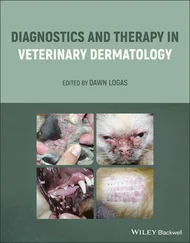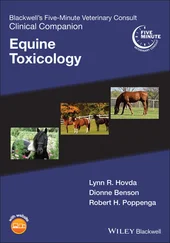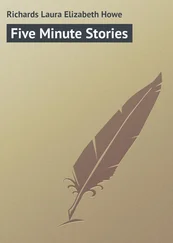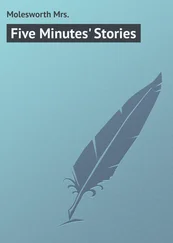Ophthalmic antibiotics applied 3–4 times daily
Ophthalmic anti‐inflammatory applied 3–4 times daily
Vitamin A must be administered only in cases with clear indication of hypovitaminosis A, otherwise there is a risk of causing hypervitaminosis A.
 FOLLOW‐UP
FOLLOW‐UP
PATIENT MONITORING
Weekly to every two‐week re‐evaluations are recommended to determine response to therapy.
EXPECTED COURSE AND PROGNOSIS
Course and prognosis will vary according to the etiology.
Prognosis for viral infections is grave as these animals typically become progressively worse over time.
For other etiologies prognosis is good to excellent.
 MISCELLANEOUS
MISCELLANEOUS
COMMENTS
Figure 2—see web image supplementary content for Section II (Chelonians).
Low for the most common etiologies.
N/A
IM = intramuscular
IV = intravenous
PCR = polymerase chain reaction
PO = per os
SC = subcutaneous
1 Di Ianni F, Dodi PL, Cabassi CS, et al. Conjunctival flora of clinically normal and diseased turtles and tortoises. BMC Vet Res 2015;11:91.
2 Lawton, MPC. Reptilian Ophthalmology. In: Mader DR, ed. Reptile Medicine and Surgery. 2nd ed. St. Louis, MO: Elsevier Saunders; 2006:323–342.
AuthorJavier G. Nevarez, DVM, PhD, DACZM, DECZM (Herpetology)
Cryptosporidium
 BASICS
BASICS
DEFINITION/OVERVIEW
Cryptosporidia are apicomplexan parasites typified by possessing an apical complex, and with four naked sporozites within each oocyte. Cryptosporidia can be distinguished from other coccidian parasites by the location that they occupy within the host cell membrane, their capacity for autoinfection, and their resistance to anti‐parasitic medication. Possessing a durable oocyst wall consisting of a double layer of a protein–lipid–carbohydrate matrix, cryptosporidia are highly resistant to environmental degradation and chemical disinfection. Historically, oocyst morphology has been used for species identification, but this is considered unreliable and species assignment is now determined by molecular characteristics. Cryptosporidia are ubiquitous in the environment and are globally distributed.
Cryptosporidium pestis has been recovered from captive tortoises, with an additional species in chelonians, C. ducismarci, yet to be ratified.
C. ducismarci has been isolated from intestinal lesions in tortoises and additionally from asymptomatic ball pythons and chameleons.
Cryptosporidium oocysts from chelonians can cause severe infections in snakes when experimentally transferred.
Transmission is direct, with reptiles becoming infected after ingesting oocysts that have been shed in feces.
Autoinfection may also occur with some oocysts releasing their sporozoites within the host’s body.
No pre‐patent period has been determined.
Infected animals usually have a history of chronic wasting accompanied by diarrhea and inappetence.
Subclinical (carrier state): animals may appear healthy and are able to shed oocysts intermittently for years.
Enteritis: a chronic debilitating enteritis without gastric involvement that may be accompanied by concurrent disease.
The greatest risk factor for developing infection is poor quarantine of new animals entering a collection.
N/A
N/A
 DIAGNOSIS
DIAGNOSIS
DIFFERENTIAL DIAGNOSIS
Enteritis—bacterial or other protozoal disease.
Examination of feces: unstained smears are useful but sensitivity of detection increases with an acid‐fast stain and is greatest with an IFA stain.
Sensitivity may be increased if performed postprandially.
An important limitation of these tests is their lack of specificity to differentiate Cryptosporidium spp.
False positive results can occur in animals that have ingested food items (i.e., mice) infected with other Cryptosporidium spp. that are not pathogenic to reptiles.
Serum antibody titers: can be assessed using an ELISA but antibodies take 6 weeks to develop. Best if combined with fecal or gastric lavage.ELISA positive, fecal positive—animal infected and shedding.ELISA negative, fecal negative—not infected.ELISA negative, fecal positive—recent infection (<6 weeks) or passing non‐reptilian Cryptosporidium spp.ELISA positive, fecal negative—has been infected at some point but not shedding or shedding at undetectable levels.
PCR: a highly sensitive test that can be used for either fecal or lavage samples. Can also differentiate between Cryptosporidium spp.
Gross: intestinal lesions may include mucosal thickening with mucus accumulation.
Histopathology: intestinal lesions consist of a mixed inflammatory response with up to 80% of epithelial cells containing parasites.
 TREATMENT
TREATMENT
APPROPRIATE HEALTH CARE
Elimination of cryptosporidia from reptiles is difficult and rarely rewarding.
Force‐feeding with easily digestible proteins.
Direct feeding by stomach tubing can be performed in some species; placement of an esophagostomy tube should be considered for chronic management.
Supportive fluid therapy should be provided.
CLIENT EDUCATION/HUSBANDRY RECOMMENDATIONS
Clients should be made aware of the insidious nature of infection, the unlikelihood of successful treatment, the risks that affected animals pose to the remaining collection, and the known zoonotic potential of some species of Cryptosporidium.
Cryptosporidium oocysts are hardy and can persist in the environment for long periods, so thorough cleaning and disinfection is important.
Methods for disinfection include:ammonia (5%) or formal saline (10%) solution contact for 18 hoursexposure to moist heat (45–60 degrees C) for 5–9 minutesfreezingthorough desiccation alone, or after any chemical application
 MEDICATIONS
MEDICATIONS
Читать дальше
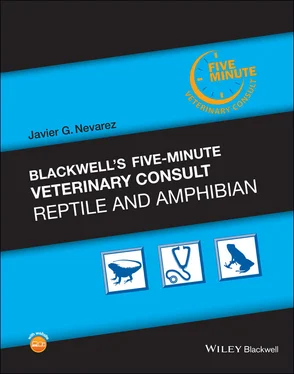
 FOLLOW‐UP
FOLLOW‐UP MISCELLANEOUS
MISCELLANEOUS BASICS
BASICS DIAGNOSIS
DIAGNOSIS TREATMENT
TREATMENT MEDICATIONS
MEDICATIONS

